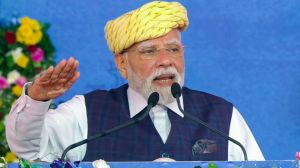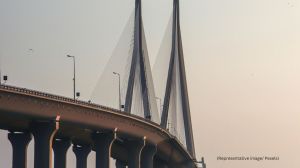Crash course on Dalal Street
AT 82, Arvind Dalal’s memory is misty. But few images stand out, images of his ‘‘mother, who made me what I am today’...

AT 82, Arvind Dalal’s memory is misty. But few images stand out, images of his ‘‘mother, who made me what I am today’’. Dalal is referring to the Bombay Stock Exchange where he earned his living since he was just 18 years old.
‘‘During the First World War, in 1942, the market was closed for six to eight months,’’ remembers the retired broker, ‘‘We all had fled to our villages in Ahmedabad and Rajasthan.’’
Vague and incomplete, yes, but Asia’s oldest stock exchange has little else as documented history. Some accounts from travellers and journalists give a glimpse of the birth and working of the BSE, but much of its history between the early 1900s and 1983, when the Sensex came into being, has gone unrecorded.
Dalal and his contemporaries are our only guides to a past that has been long forgotten. Of crashes and booms, of profits and losses made at Dalal Street.
Dalal saw his first big crash on February 28 in 1947, when Liyaqat Ali declared his budget. ‘‘It was anti-Hindu,’’ he declares as if it was reason enough to bring the market down by 8.5 per cent in a day. ‘‘The budget introduced a business tax, over and above the income tax,’’ adds 80-year-old Vasantlal Kantilal Shah, former BSE vice-president.
Panic-stricken brokers pushed the price of Tata Steel Deferred, the most popular share at the time, from Rs 2,601 to Rs 2,380 on February 28, and finally Rs 1,765 on May 27. Though the market was closed for nearly a month, in two intervals, stock prices continued to slide in the unofficial market. These were called ‘kerb deals’ i.e. trading after market hours.
‘‘Kerb deals took place even during normal market conditions,’’ explains G B Desai, former president of the BSE. Though the market would officially open from 12 pm to 2 pm, unofficially it functioned for 24 hours.
‘‘There were specialised kerb brokers who would execute deals over the phone,’’ adds Desai.
‘‘When news came in October 1962 that the ‘frontier guardsmen’ had entered Bombdilla, markets crashed 30 to 40 per cent,’’ remembers M R Mayya, 73, former BSE executive director.
Then 30 years old, Mayya working with the Forward Markets Commission which controlled the commodities market. Gold and silver markets were stopped, and trading in all commodities was banned. ‘‘It was an era of shortages,’’ remembers the veteran.
The market was officially closed for a week. Even back then, the spread of information played a key role in the slide of share prices. News would come to the market from the Reuters machine, which was the privilege of big brokers.
On the evening of June 27, 1969, perhaps the only thing soaring higher than the temperature was the hysteria at the stock market.
In his budget announced at 6 pm, the then finance minister Morarji Desai had banned forward trading, or what was then called ‘contracts for clearing’. ‘‘Many leading scrips tumbled down the same day,’’ observes the RBI bulletin of July 1969. ‘‘For example, Tata Steel was quoted around Rs 112 against the official closing of Rs 123.50 and Century around Rs 700 against the official Rs 761.50.’’
Clearly, share prices had fallen from 8.78 per cent to 17.2 per cent. ‘‘Phiroze Jeejebhoy (the then BSE chairman) rang the closing bell by 1 or 1.30 p.m.,’’ the snow white-haired Shah remembers. That was half an hour before official closing time.
‘‘It was the rainiest Friday in 1974,’’ Mayya looks up from his notebook. ‘‘Prices crashed by 25 per cent. Market leader Century Mills dropped from Rs 600.50 to Rs 424 overnight.’’
The market was reacting to the restrictions introduced by Indira Gandhi on July 6, 1974 on the payment of dividend. The new legislation restricted the payment of dividend to one third of distributable profit or 12 per cent of face value of share, whichever was lower. With such low returns on shares, everyone wanted to get rid of their stock.
Panic selling caused the market to be shut for a week. It was reopened after fixing a ‘floor price’ i.e. a minimum price at which the shares can be traded. This was nearly 17 per cent below the official closing prices.
Though each crash brought huge losses, there were hardly any defaults. ‘‘The biggest credit to my era was that no matter how big the crises, all promises were always honoured,’’ stresses Dalal. ‘‘Our word was our bond,’’ echoes Desai, explaining that even though transactions took place verbally, they were as good as the written word.
Small investors made their debut in the stock market in 1976, when the Foreign Exchange Regulation Act made it compulsory for foreign companies, like Hindustan Lever and Colgate, to divest their stake. Soon 120 companies offered shares worth Rs 150 crore, and the market revived.
On April 1, 1983, Mayya helped set up the BSE Sensitive Index with its base as 100 in 1979. It went on to become the measure of health of the country’s largest stock exchange.
Photos



- 01
- 02
- 03
- 04
- 05




























